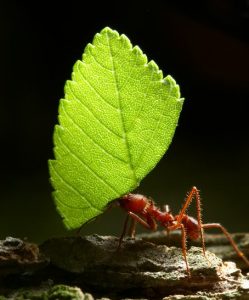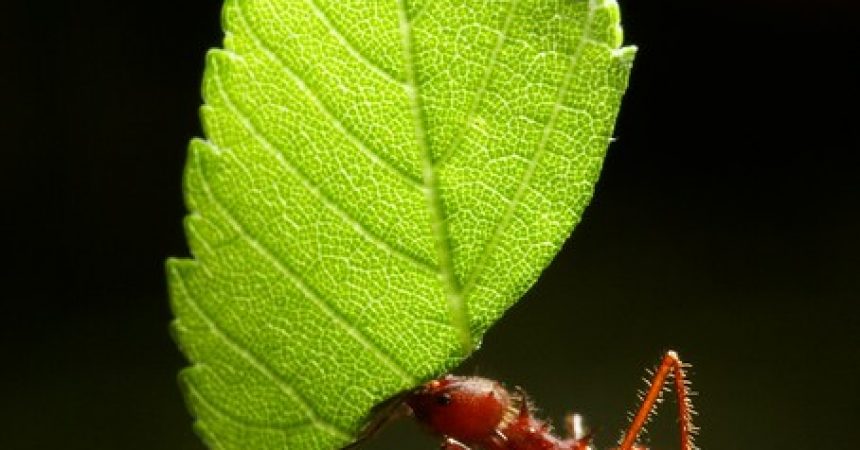Zoo InternQuest is a seven-week career exploration program for San Diego County high school juniors and seniors. Students have the unique opportunity to meet professionals working for the San Diego Zoo, Safari Park, and Institute for Conservation Research, learn about their jobs and then blog about their experience online. Follow their adventures here on the Zoo’s website!
 Who takes flight to begin a new adventure, only to come crashing down in a foreign world, all alone, and must grow food to survive from decomposing matter? No, I’m not talking about Matt Damon from The Martian, though he does match this description. The “Martian” I’m thinking of lives right here on this planet and is 21 million times smaller than a person. Last Wednesday, I had the honor to meet Esther Chang, a Senior Insect Keeper at the San Diego Zoo. We listened as Ms. Chang amazed us with facts about insects. The bugs that struck me as the most fascinating were the leaf cutter ants, whose queens go through similar journeys as Matt Damon long before he blasted off on his.
Who takes flight to begin a new adventure, only to come crashing down in a foreign world, all alone, and must grow food to survive from decomposing matter? No, I’m not talking about Matt Damon from The Martian, though he does match this description. The “Martian” I’m thinking of lives right here on this planet and is 21 million times smaller than a person. Last Wednesday, I had the honor to meet Esther Chang, a Senior Insect Keeper at the San Diego Zoo. We listened as Ms. Chang amazed us with facts about insects. The bugs that struck me as the most fascinating were the leaf cutter ants, whose queens go through similar journeys as Matt Damon long before he blasted off on his.
The story of a leafcutter ant begins as the future queen ant attempts to start her own colony. The first step of this process happens when the female ant takes flight. In the air, she will mate with between six and eight male ants. After the mating is finished, all the ants will land but only the females survive. This event only happens once in a queen ant’s life, preparing her to continuously produce more ants during her 15-20 year life. She then finds a piece of fungus, places it in her mouth, and begins work to dig the tunnels for her future colony.
The leaf cutter ants are one of the most sophisticated types of ants since they have designated tasks for each member of the colony. The queen ant is the reproducer and spends her whole life giving birth to more ants. So she can focus on reproducing, the younger members of the tribe care for her by feeding her and even moving her if necessary. These juvenile ants also care for the fungus, which serves as their main source of food. As they age, the caretaker ants take on the task of harvesting materials from plants, such as leafs, and carry back them to the colony for the fungus to decompose resulting in growth. Soldier leafcutter ants are naturally bigger than the rest of the ants and are raised to help protect the colony. They will fend off any attacker by using their powerful mandibles, otherwise known as pinchers by most of us as kids. Once the harvesting ants become even older they maintain the cleanliness of the underground tunnels and rooms by getting rid of any waste or even dead leaf cutter ants.
More aspects of the complexity of this species are seen in their organization and communication with one another. The tunnels are laid out so that they connect to a series of rooms that the ants use for different purposes. Most of the rooms are used for growing fungus. As mentioned earlier, the fungus is farmed by leafcutter ants through the decomposition of other plants. In order to aid in this process, the ants will create entire rooms dedicated to growing fungus. Also, the elder ants need some space to place all the trash they collect, therefore, all leafcutter ant colonies have a trash room.
Communication is vital for a colony of leafcutter ants to survive. A common misconception about ants is that the queen controls the entire colony. Ants in general communicate through the use of pheromones. Pheromones are a specific scent an ant will give off in certain situations. For example, once a leafcutter ant soldier bites a trespasser, they release a pheromone onto the victim that other soldiers can smell to distinguish it as an enemy. Pheromones serve as a sort of scent path for harvesting ants; it marks the way they took to a food source for other ants to follow. As more ants participate in any task, a stronger pheromone is left so that the ants can efficiently work together. So, you may wonder, what does the queen have to do with this? Good question, the queen gives off a special pheromone that unites the colony and inspires them. Without a queen releasing this pheromone, an entire colony of ants will quickly become dejected, stop taking care of the fungus, and no longer forage for food.
Ms. Chang explained how the leafcutter ants perfectly fit into their niche of the environment. They indirectly support life through the trash room by providing shelter for many other species of bugs. A great way you can help keep these amazing ants alive is by being aware of what you put on your plants. Imagine how quickly Matt Damon’s adventure would have ended if he had unknowingly ruined his life saving potatoes with dangerous chemicals. In the same way, many species of native insects rely on us being careful not to use harmful pesticides on plants so that they can continue to go on more martian-esque expeditions.
Noah, Species Spotlight Team
Week Two, Fall Session 2018


